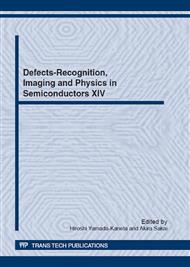[1]
P. Jackson, D. Hariskos, E. Lotter, S. Paetel, R. Wuerz, R. Menner, W. Wischmann, M. Powalla, New world record efficiency for Cu(In,Ga)Se2 thin-film solar cells beyond 20%, Prog. Photovolt.: Res. Appl. 19 (2011) 894-897.
DOI: 10.1002/pip.1078
Google Scholar
[2]
F.-J. Haug, H. Zogg, A. N. Tiwari, 11% EFFICIENCY ON CIGS SUPERSTRATE SOLAR CELLS WITHOUT SODIUM PRECURSOR, Conference Record of 29th IEEE Photovoltaic Specialists Conference, New Orleans, USA, (2002) p.728.
DOI: 10.1109/pvsc.2002.1190668
Google Scholar
[3]
T. Nakada, Y. Hirabayashi, T. Tokado, D. Ohmori, T. Mise, Novel device structure for Cu(In,Ga)Se2 thin film solar cells using transparent conducting oxide back and front contacts, Sol. Energy 77 (2004) 739-747.
DOI: 10.1016/j.solener.2004.08.010
Google Scholar
[4]
S. Ikeda, R. Kamai, S. M. Lee, T. Yagi, T. Harada, M. Matsumura, A superstrate solar cell based on In2(Se,S)3 and CuIn(Se,S)2 thin films fabricated by electrodeposition combined with annealing, Sol. Energy Mater. Sol. Cells 95 (2011) 1446-1451.
DOI: 10.1016/j.solmat.2010.11.006
Google Scholar
[5]
S. Osada, Y. Abe, T. Anegawa, T. Minemoto, H. Takakura, Cu(In,Ga)Se2 solar cells with superstrate structure using lift-off process, Sol. Energy Mater. Sol. Cells 95 (2011) 223-226.
DOI: 10.1016/j.solmat.2010.03.033
Google Scholar
[6]
Y. Abe, T. Minemoto, S. Osada, H. Takakura, Lift-off process reducing crack formation and its Cu(In,Ga)Se2 thin film solar cell applications, Sol. Energy 85 (2011) 2101-2107.
DOI: 10.1016/j.solener.2011.05.018
Google Scholar
[7]
T. Anegawa, Y. Oda, T. Minemoto, H. Takakura, Comparison of lift-off processes and rear-surface characterization of Cu(In,Ga)Se2 thin films for solar cells, J. Cryst. Growth 311 (2009) 742-745.
DOI: 10.1016/j.jcrysgro.2008.09.136
Google Scholar
[8]
T. Negami,T. Satoh, Y. Hashimoto, S. Shimakawa, S. Hayashi, M. Muro, H. Inoue, M. Kitagawa, Production technology for CIGS thin film solar cells, Thin Solid Films 403-404 (2002) 197-203.
DOI: 10.1016/s0040-6090(01)01524-3
Google Scholar
[9]
Y. Hashimoto, S. Nishiwaki, T. Negami, T. Wada, Stabilization of Manufacturing Process of CIGS Solar Cell with Treatment of CIGS Surface by In and S Containing Solution, Jpn. J. Appl. Phys. Suppl. 39-1 (2000) 415-417.
DOI: 10.7567/jjaps.39s1.415
Google Scholar
[10]
M. Froment, M. C. Bernard, R. Cortes, B. Mokili, D. Lincot, Study of CdS Epitaxial Films Chemically Deposited from Aqueous Solutions on InP Single Crystals, J. Electrochem. Soc. 142 (1995) 2642-2649.
DOI: 10.1149/1.2050067
Google Scholar
[11]
I. O. Oladeji, L. Chow, Optimization of Chemical Bath Deposited Cadmium Sulfide Thin Films, J. Electrochem. Soc. 144 (1997) 2342-2346.
DOI: 10.1149/1.1837815
Google Scholar



